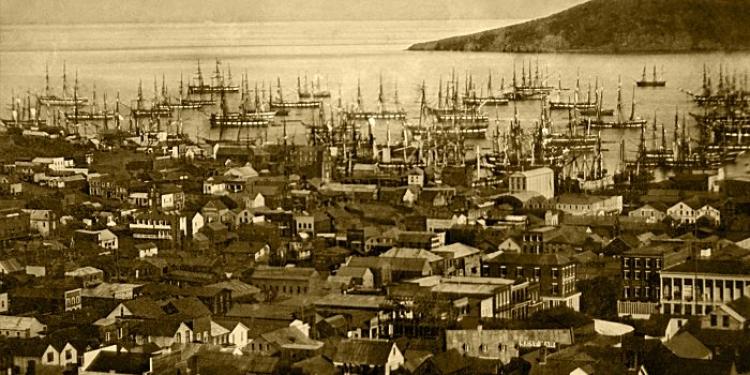A History of Gambling in America (part4)
Posted: July 25, 2015
Updated: October 6, 2017

As more attention was drawn to the moral fibre of America, all eyes looked west
Gambling was rampant throughout America by the end of the 19th century. This is largely because every part of society that worked to define the U.S., carried with them previous gambling cultures which were practiced before the setters first appeared on American soil. The Native Americans, British Settlers, the African Slaves brought with them and the Chinese all had a love for gambling that previously existed in their own cultures.
Just as politicians, such as President Andrew Jackson wished, gambling was made available to the masses. Along river boats everyone aboard gambled. Soon all the attention would move towards the west and the influx of gold that was to be found. Soon new gambling areas would emerge that allowed everyone to gamble regardless of background. Once again US gambling news would have its day.
Before the end of river boat gambling, thousands of gamblers were heading west. Gold was discovered in Sutter’s Mill in 1848, and along with it a slew of miners followed hoping to be rich. These prospectors worked diligently by night, but were without anything to do at night. As a result they would gamble. This practice took place almost anywhere including on cattle drives, blankets, horseback, and on stagecoaches.
Unfortunately, along with the prevalent gambling came violence by means of the revolver. Towns such as Dodge City and Tombstone sprung up and quickly gained notoriety for their quick ways of living and dying. These towns were seen as “ripe for the picking” by professional gamblers who led transient lifestyles. These gamblers would take the gold dust from the prospectors at night and then they would come back the next night with replenished funds from their mines.
In the west, the revolver proved to be the new form of US gambling law. Out of all the towns sprawling with gambling in the west, none surpassed the splendor of San Francisco, the Mecca of gambling in the west. Just one year after gold’s discovery, hundreds of gambling establishments were in San Francisco. It was there that the first contemporary casinos were built with long tables and roulette.
Unlike back east, anybody regardless of race, nationality or religion could enter and place bets. Mexican, Chinese, Africans, Native Americans, rich and poor were equally given the chance to lose their money. The competition between gamblers was so fierce, that gambling in San Francisco was for some time considered an “admirable profession.”
Throughout San Francisco, whether in Chinatown or the Barbary Coast, gambling casinos took on the flavor of their areas. Portsmouth Square was the epicenter for casinos with gigantic rooms with crystal chandeliers in the air and fine works of art on the walls. On the floor below free food was offered to patrons and beautiful women who were hired to convince betters to wage more. These activities were worlds away from the mobile casino gambling seen today.
One of the main attractions in Portsmouth Square was an attractive female card dealer by the name of Eleanor Dumont. The first known female to appear in San Francisco, she worked out of the Union Bella Casino. Within a year of her arrival, every major casino in the city had at least one female dealer. Female dealers proved valuable as they drew many men who took pleasure in having their money taken by a lady.
Also, because of traditional ways women have been views, when men lost their money to a female dealer, they would just “laugh it off condescendingly” and just wage again. Dumont left the gambling scene in San Francisco and reemerged in Nevada City, just north. Dumont made gambling news when she opened the new Bella Union Casino on Broad Street and started to grow a moustache. Soon punters would travel from all-round to see Dumont who went by the name Madame Moustache.
Back in San Francisco, people like James King, Editor of the San Francisco Daily Evening Bulletin, were frustrated with the image his city had due to gambling. As San Francisco was growing into a world-renown destination, King would start a campaign against gambling though his newspaper. In it, King would name notorious gamblers and raise the questions to local officials about how to solve the problem.
Gambling was rampant throughout America by the end of the 19th century. This is largely because every part of society that worked to define the U.S., carried with them previous gambling cultures which were practiced before the setters first appeared on American soil. The Native Americans, British Settlers, the African Slaves brought with them and the Chinese all had a love for gambling that previously existed in their own cultures.
• Frontiersmen would gamble on cattle drives, blankets or horseback
• Eleanor Dumont was the first female dealer to appear in San Francisco
• James King would use his newspaper to campaign against gambling
Just as politicians, such as President Andrew Jackson wished, gambling was made available to the masses. Along river boats everyone aboard gambled. Soon all the attention would move towards the west and the influx of gold that was to be found. Soon new gambling areas would emerge that allowed everyone to gamble regardless of background. Once again US gambling news would have its day.
Sutter’s Mill begins a new frontier for gamblers

Sutter’s Mill, where James W. Marshall found the first gold flakes, starting off the Gold Rush
Before the end of river boat gambling, thousands of gamblers were heading west. Gold was discovered in Sutter’s Mill in 1848, and along with it a slew of miners followed hoping to be rich. These prospectors worked diligently by night, but were without anything to do at night. As a result they would gamble. This practice took place almost anywhere including on cattle drives, blankets, horseback, and on stagecoaches.
Unfortunately, along with the prevalent gambling came violence by means of the revolver. Towns such as Dodge City and Tombstone sprung up and quickly gained notoriety for their quick ways of living and dying. These towns were seen as “ripe for the picking” by professional gamblers who led transient lifestyles. These gamblers would take the gold dust from the prospectors at night and then they would come back the next night with replenished funds from their mines.
In the west, the revolver proved to be the new form of US gambling law. Out of all the towns sprawling with gambling in the west, none surpassed the splendor of San Francisco, the Mecca of gambling in the west. Just one year after gold’s discovery, hundreds of gambling establishments were in San Francisco. It was there that the first contemporary casinos were built with long tables and roulette.
Unlike back east, anybody regardless of race, nationality or religion could enter and place bets. Mexican, Chinese, Africans, Native Americans, rich and poor were equally given the chance to lose their money. The competition between gamblers was so fierce, that gambling in San Francisco was for some time considered an “admirable profession.”
The splendor of the gambling city of San Francisco

There were a lot of men with a lot of gold, out for a good time – Gambling was fervent
Throughout San Francisco, whether in Chinatown or the Barbary Coast, gambling casinos took on the flavor of their areas. Portsmouth Square was the epicenter for casinos with gigantic rooms with crystal chandeliers in the air and fine works of art on the walls. On the floor below free food was offered to patrons and beautiful women who were hired to convince betters to wage more. These activities were worlds away from the mobile casino gambling seen today.
One of the main attractions in Portsmouth Square was an attractive female card dealer by the name of Eleanor Dumont. The first known female to appear in San Francisco, she worked out of the Union Bella Casino. Within a year of her arrival, every major casino in the city had at least one female dealer. Female dealers proved valuable as they drew many men who took pleasure in having their money taken by a lady.
Also, because of traditional ways women have been views, when men lost their money to a female dealer, they would just “laugh it off condescendingly” and just wage again. Dumont left the gambling scene in San Francisco and reemerged in Nevada City, just north. Dumont made gambling news when she opened the new Bella Union Casino on Broad Street and started to grow a moustache. Soon punters would travel from all-round to see Dumont who went by the name Madame Moustache.
Back in San Francisco, people like James King, Editor of the San Francisco Daily Evening Bulletin, were frustrated with the image his city had due to gambling. As San Francisco was growing into a world-renown destination, King would start a campaign against gambling though his newspaper. In it, King would name notorious gamblers and raise the questions to local officials about how to solve the problem.
Related content
Subscribe
0 Comments












